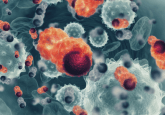Continuing our coverage of the GetReal Conference 2024 (May 14–15, 2024, Utrecht, The Netherlands), here we summarize the sessions from day 2 of the conference.
Click below to read the coverage of Day 1
Day 1
Sessions 5a and b – Methods Deep-Dive: A Scientific Discussion on RWE Methods Being Applied
The scientific value of RWE for patients
To begin Day 2’s two-part morning session focused on real-world evidence (RWE) methods, Bettina Ryll (MPNE, Sweden) set the scene. Drawing from personal experience with her husband’s metastatic melanoma diagnosis, Ryll highlighted the pivotal need for RWE to avoid exposure to ineffective treatments and emphasizing the importance of capturing patient-centric outcomes that traditional clinical trials often overlook, such as quality of life and long-term side effects. Ryll called out some examples, including Bijwerkingencentrum Lareb and VigiAccess, which allow direct patient reporting and uncover insights often missed by traditional reporting methods. Ryll also highlighted PRIME-ROSE (PRecisIon Cancer MEdicine RepurpOsing SystEm Using Pragmatic Clinical Trials), which aims to improve cancer treatment outcomes by integrating drug repurposing with precision medicine and real-world clinical trial methodologies. Furthermore, Ryll stressed the ethical imperative of data usage and the need to protect patient privacy and prevent misuse, calling for robust data governance frameworks to ensure responsible data utilization.
Applied RWE methods across drug development and lifecycle management
The second speaker of the morning session was Delphine Saragoussi (Evidera, France), who was speaking on behalf of the International Society of Pharmacoepidemiology (ISPE) and her role on the organization’s RWE Collaborative Special Interest Group (SIG). Saragoussi began by providing an overview of ISPE, which is an international association dedicated to advancing the health of the public by providing a global forum for discussion, sponsoring educational activities and advocating for pharmacoepidemiology. She highlighted the convergence of the objectives of the RWE SIG and those of the GetReal Institute.
Saragoussi proceeded to provide an overview of the significance of RWE in pharmacovigilance and pharmaceutical research. She provided an overview of the components of RWE, comprising data, study designs and analysis methods, delineating between traditional sources like electronic medical records and innovative sources such as social media data and artificial intelligence. She expounded on the diverse applications of RWE, encompassing pre-marketing studies like natural history and burden of illness assessments, as well as post-marketing endeavors focusing on safety monitoring and vaccine effectiveness. Additionally, Saragoussi shared some of the challenges and incentives inherent in RWE development, citing issues such as data quality and budget constraints alongside motivations such as the ability to address therapeutic needs and enhancing methodological validity. Ultimately, she underscored the importance of selecting appropriate methods tailored to specific study objectives, thereby ensuring scientific rigor and relevance in RWE applications.
Syntactic and semantic harmonization in transforming RWD to RWE: examples from VAC4EU and ConcePTION
The final speaker of part one of the morning session was Miriam Surkenboom (VAC4EU, The Netherlands), who highlighted two examples of RWE needs:
- Collaboration for vaccine monitoring
- RWE on safety of medicines in pregnancy (given the lack of inclusion in clinical trials)
Surkenboom provided two examples to illustrate these needs; regarding vaccine monitoring, she highlighted the VAC4EU collaboration, which is a multi-stakeholder international association designed to deliver on the vision of the ADVANCE project, to, “enable robust and timely evidence-generation on the effects of vaccines in a collaborative manner in Europe for use by citizens, healthcare professionals, public health organizations and regulatory agencies.” Regarding medicine safety in pregnancy, Surkenboom discussed IMI ConcePTION, aiming to, “reduce uncertainty about the effects of medication used during pregnancy and breastfeeding to benefit women in making informed decisions about medications used before, during and after pregnancy.” Both initiatives aim to establish ecosystems for generating RWE on these critical topics.
With these examples in mind, Surkenboom highlighted the need for collaboration to address data accessibility challenges and ensure comprehensive data utilization within Europe. Surkenboom discussed the research infrastructure for both VAC4EU and ConcePTION, with VAC4EU adopting the ConcePTION common data model as a basis for the structural harmonization of electronic health data. Collaboration across various sites with access to RWD was emphasized, with a focus on principles like local data retention and fitness for purpose assessment. Harmonization, involving standardization of data structures (syntactic harmonization) and of terminologies (semantic harmonization), emerged as a crucial step to ensure data comparability and enhance evidence generation efficiency.
Using target trial emulation for estimation of treatment effects using RWD
Following the coffee break, part two of the morning session got underway with a presentation from Manuel Gomez (UCL, UK) on exploring target trial emulation (TTE) specifically within comparative effectiveness research. Gomez began by emphasizing the focus of TTE on good study design principles. He highlighted the importance of articulating clear, relevant questions and minimizing potential flaws in RWD analysis, and outlined the three main steps of TTE:
- Specifying the target trial protocol
- Emulation
- Estimating treatment effects
He discussed various challenges and considerations in this process, such as issues with differences in study population, differences in treatment strategies, and capturing protocol effects. Gomez also touched on methods for addressing biases, including sensitivity analysis and quantitative bias analysis. He illustrated these concepts with an example of a head-to-head comparison trial – a good example of the use of TTE, given that randomized trials are not designed to provide this information – citing the recent publication from Boyne et al.
Audience Q&A
The morning’s presentations concluded with an audience Q&A and panel discussion, with the discussion centered on the convergence of RWD methodologies for regulatory and HTA decision-making. Participants explored topics such as methodological guidance, convergence in approaches, gaps in current guidelines, and challenges in implementing quality frameworks for data assessment. There were also discussions on the importance of harmonizing guidelines, the need for clear reporting standards, and strategies for bridging differences in decision-making objectives across various healthcare systems. Overall, the session highlighted the ongoing efforts to integrate RWD into decision-making processes while addressing methodological challenges and fostering collaboration among stakeholders.
Session 6 – Keynote: A Vision for The Future: What If We Accelerate The Convergence of Regulatory & HTA?
Shahid Hanif welcomed Patrice Verpillat (European Medicines Agency’s [EMA], The Netherlands), who also spoke on Day 1, and Niklas Hedberg (Dental and Pharmaceuticals Benefits Agency [TLV], Sweden) to provide their perspectives on the convergence of regulatory and HTA. In his presentation, Verpillat highlighted the distinct evidence requirements of regulators and HTA bodies: regulators determine efficacy through randomized controlled trials (RCTs) versus placebo, while HTA bodies evaluate comparative effectiveness through RCTs against the standard of care or active comparators. Both entities, he stressed, must develop strategies to manage uncertainty.
Verpillat elaborated on DARWIN EU, a key initiative for delivering RWE in the EU, and identified three main areas where RWD analyses support EMA decision-making: understanding clinical context, supporting planning and validity, and investigating associations and impacts, which align with HTA needs. He referred the audience to an October 2022 workshop that examined DARWIN EU’s potential to support HTA decision-making and shared an example of natural history study in multiple myeloma from this initiative, which can be used by payers and HTA bodies in their decision-making.
Verpillat emphasized the long-standing collaboration between the EMA and HTA bodies through various EMA committees and noted opportunities through parallel joint scientific consultations under Regulation (EU) 2021/2282EN on health technology assessment (HTAR) would further accelerate convergence. HTAR also offered other avenues for convergence; for example, by enabling prospective planning of post-licensing/launch evidence generation that addresses evidence needs by HTAs and regulators. He concluded by underscoring shared principles for the use of RWE between HTA bodies and regulators to enhance transparency and manage uncertainty.
In the following presentation, Hedberg discussed the ongoing challenge between external and internal validity in research, highlighting the ideal scenario where both types of validity are combined, although this remains unlikely at present. He aligned with Verpillat’s point on the varying evidence requirements for regulatory and HTA bodies, emphasizing the distinct needs of demonstrating efficacy (“does it work?”) versus demonstrating superiority (“does it work better?”) Hedberg expressed a desire for HTA and regulatory bodies to work complementarily rather than duplicating efforts, stressing the importance of innovation in this collaborative process.
Hedberg underscored the necessity for collaborative advancements in scientific methods, infrastructure development and the initiation of pilot projects to drive progress. With the increase in RWD, he noted a significant shift in the balance of power within the research landscape. He cautioned that formulating the right research questions requires careful consideration, as organizations with access to RWD datasets hold considerable influence.
Hedberg suggested that resistance to utilizing RWE often stems from companies developing new products, who may be apprehensive about the outcomes of studies based on RWD. He stressed the importance of fair comparisons in evidence generation and warned against practices such as data mining and phishing, which can lead to confusion due to an overabundance of studies. Despite the potential benefits of RWD, Hedberg acknowledged that it will not address underlying ethical challenges. He concluded by criticizing the duplication of efforts in research as a waste of time and resources, advocating for a more streamlined and cooperative approach to evidence generation across HTA and regulatory bodies.
Session 7 – Closing Discussion: Regulatory & HTA Town Hall
In a dynamic multi-stakeholder panel moderated by Niklas Hedberg, participants shared their insights from the discussions held over the past 2 days of the conference and highlighted what they believe should be the top priorities for the field.
Patrice Verpillat began by addressing the significant progress made in the HTA and regulatory landscape, emphasizing the importance of evidence generation and collaboration. He praised the open discussions facilitated by the GetReal Institute and described DARWIN EU as a ‘game-changer’. Verpillat expressed optimism about the ongoing journey and shift in mindset towards collaborative efforts, drawing parallels to the collaborative model seen during the COVID-19 pandemic, which acted as a catalyst for integrating RWE into decision-making processes.
Donna Rivera (FDA, USA), joining the discussion virtually, continued the regulatory perspective and echoed the sentiments of collaborative working. She emphasized the collective effort to determine the success of RWE in regulatory decision-making and noted the importance of discussing the next steps to advance the field. Donna highlighted the necessity of leveraging the conference’s outcomes to push the field forward.
Iñaki Gutiérrez-Ibarluzea (BIOEF, Spain) focused on the robustness of innovative methods to reduce uncertainty around the use of RWD. He raised critical questions about which methods to adopt, given the varying requirements of regulators, HTA bodies and assessors. Gutiérrez-Ibarluzea stressed the need for including the voices of payers, citizens, and policymakers in the conversation, calling for greater transparency.
Elena Petelos (University of Crete/HTAi, Greece), also presenting virtually, underscored the significance of the European Health Data Space (EHDS) and the explicit mention of RWD/E within this context. She highlighted the cultural and methodological shifts required within organizations and the efforts towards harmonizing data standards and hospital data. Petelos welcomed discussions on methodologies and data quality for HTA and called for broader, more transparent dialogues involving regulators, payers and global stakeholders.
Wim Goettsch (University of Utrecht, The Netherlands) noted the political aspects of RWE, acknowledging the inherent uncertainties and the need to leverage ongoing European efforts, for example through the EU-funded SUSTAIN HTA project. He appreciated the openness between HTA bodies and regulators but recognized the need to move beyond the ‘RWE bubble’. Wim suggested fostering more dialogues with other HTA bodies and collaborating with groups like ISPOR, ISPE, and HTAi to enhance awareness and use of RWD.
Bettina Ryll (Melanoma Patient Network Europe, Sweden) shared her thoughts on the value of exchange at the GetReal Conference. She called for increased awareness around data sources and the ethical use of RWD, particularly regarding consent. Ryll emphasized the need to involve more clinicians in the discussions, as their perspectives can provide valuable insights into the datasets that regulators and HTA bodies use. She cautioned against oversimplifying complex systems and advocated for learning opportunities from pilot projects and investing in innovative capacities. Drawing on the COVID-19 experience, Bettina encouraged more exploration and a push to expand the boundaries of RWE, noting that the current approach is too cautious.
Following these reflections, Hedberg moderated an interactive discussion between the panelists and audience, exploring some of the themes raised. This included ways to ‘break the RWE bubble’ to include more stakeholders, appropriate ways to incentivize clinicians for better primary data collection, and democratization in research with RWD. The session closed with each of the speakers making their own recommendations to advance the field.
Register to access all content on The Evidence Base
In the coming weeks, we’ll delve deeper into the discussions from this 2-day event, offering comprehensive analyses of some of the sessions. Register to The Evidence Base for regular updates and notifications when new coverage is available on the site.
Register here







